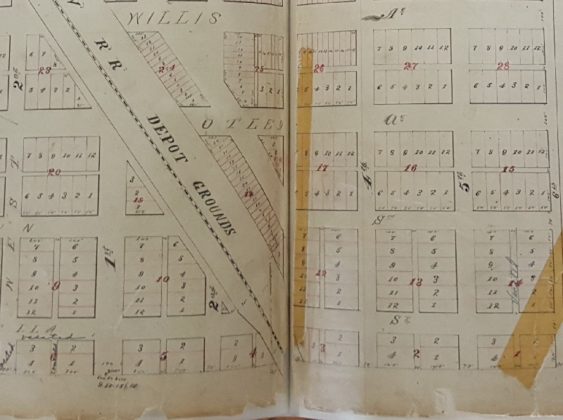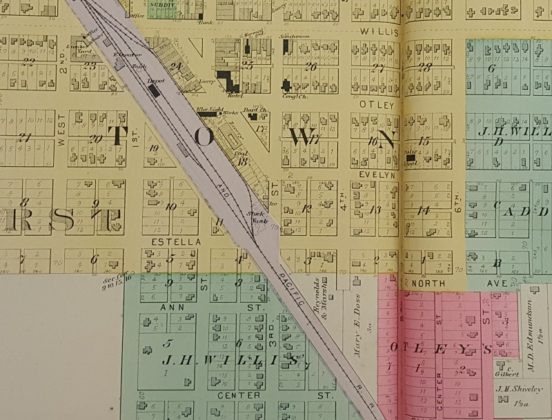
No good deed goes unpunished, Oscar Wilde said.
Larry and Diana Carpenter of Perry, owners of Mid-Am Textiles Inc. at 809 Railroad St. in downtown Perry, thought they were doing a good deed by cleaning up the waste land around their warehouse and pouring a concrete pad. They even had the blessing of the city.
Or so they thought.
They were surprised July 17 when they received a letter from the city that read: “You are hereby notified to abate the nuisance at 809 Railroad St. within 30 days from the service of this notice or submit a written request. The nuisance consists of an excess concrete slab being poured around five feet away from the edge of the trail.”
The letter said their concrete driveway “wasn’t authorized by the engineer or any city official.” They could abate their nuisance, the letter said, “by removing all concrete that is at least 20 feet close to the edge of the bike trail and reseeding the affected area.”
The city of Perry owns a 20-foot right of way on each side of the Raccoon River Valley Trail.
The Carpenters brought their nuisance-abatement issue before the Perry City Council Sept. 17, and Larry Carpenter outlined the recent history — and not-so-recent history — of his property, which includes a former spur track of the Union Pacific Railroad.
The Carpenters moved to Perry in 2012 after living 24 years in Adel and running their paper-products business in De Soto. They bought their first Railroad Street property from Richard Saemisch in 2011, with an adjoining lot bought from John Glass the same year. They bought the third lot — the old spur track — from Jerome Wuebker in late 2015.
The spur track dates from the days of the Des Moines Valley Railway, the first railroad line laid through Perry 150 years ago. The track ran diagonally through town, from southeast to northwest, and the crosswise layout later produced Railroad Street and the unique triangular block where the Carnegie Library Museum now stands.
The Des Moines Valley Railway was acquired in 1912 by the Minneapolis and St. Louis Railway, and it later became part of the Chicago, Rock Island and Pacific Railway. When the Rock Island Line filed for bankrupcy in 1975, its Perry track was acquired by the Chicago and Northwestern Railway, which in turn merged with the Union Pacific Railroad in 1995.
The track continued to be used to haul UP freight until about 2004. It is now the city-owned portion of the north loop of the Raccoon River Valley Trail, with the 20-foot right of way on each side. The portion of the old rail grounds owned by the Carpenters was once a stockyard and in more recent years became a dump for all manner of rubbish.
Carpenter said cleaning up the ground meant hauling away 30 dump truck loads — that is, 450 tons — of accumulated blocks, bricks, rocks, car parts and sundry junk. After clearing and grading the lot, he started pouring concrete, he said, but only after getting the go-ahead from the city.
“In the fall of 2015,” Carpenter told the council, “I called (former Perry Building Official) Steve Tibbles and asked about finishing the approach up to the bike trail and leveling the concrete on the property next to the bike trail. He said he would have to discuss the matter with a couple of city officials. Steve and three city officials came down to look at the property.”
Carpenter said he believed Perry City Administrator Sven Peterson was among the official foursome who visited his property in 2015, but Peterson told the council he did not recall such a meeting.
“I could have sworn you were there, Sven,” Carpenter said. At any rate, he said, whoever the visiting city officials were, “they agreed the approach should be concreted up to the bike trail but stop short of the bike trail on the spur track property. They told me to go up to the bike trail in front of the building but then, when we were talking about the spur track, they said they would prefer if I didn’t have to go all the way up but to have a break there.”
Following these directions, Carpenter paved to within about five feet of the bike trail, which was well inside the city’s right of way. Since the directions he received were not reduced to writing, Carpenter now has no tangible proof they were ever truly given, but he points to his own open-handed actions as circumstantial evidence.
“The project started in late 2015,” Carpenter said. “I’ve had cones, flashing barricades, concrete trucks, my own bulldozer — I mean, I have not done this in secret. It’s in full view for everyone to see. I’ve done it during the day. I wave at the city guys when they drive by. It’s not like I’ve tried to hoodwink someone.”
The city council seemed inclined to favor Carpenter. Peterson presented the city view.
“The biggest thing is that there was concrete poured on our property,” Peterson said. “I guess I don’t know what the agreement was when Steve was around and what all happened there, but there’s no official action to allow that.”
Council member Chuck Schott asked whether the city was in any way suffering as a result of Carpenter’s concrete encroachment.
“In your opinion, what’s the concrete hurting, other than the fact that it’s on our property?” Schott said. “What damage is it doing to anything or any cause or any way through, other than the fact that it’s on our property?”
Peterson said the city’s main interest might lie in having the property relations legally documented.
“I think it is a little close to the trail and kind of encroaching a little bit on that corridor,” he said. “It’s obvious that something is kind of encroaching there, so I think that whether the council decides they do need to take it out or give them some sort of egress easement or something like that, we just need something on the books.”
Carpenter claimed his pavement is a benefit to the city.
“We’ve removed a nuisance,” he told the council, not created one. “By using the paved section of the property,” he said, his delivery trucks “are able to stay off the bike trail, street and sidewalks.”
Perry City Council member Dean Berkland praised Carpenter’s work on the scrub ground.
“I’ve ridden my bike past there every day,” Berkland said. “In my mind you’ve done a nice job cleaning that all up. It was really a mess when you started.”
On the day after the Sept. 17 city council meeting, Carpenter again received a delegation of city officials, including Perry Mayor John Andorf, Schott, Peterson and City Building Official Abraham Cardenas. Other council members stopped in at other times, too. Negotiations proved fruitful.
“The mayor came down the next morning,” Carpenter said, “and I know at least two of the city council members did. They proposed I take off five foot of that. I don’t see any problem with what’s there now, but I think it’s good that we talk and negotiate. So I agreed to that. I appreciated that they took it serious.”
The merchant was also pleased by the overall experience of dealing with city hall.
“I think we got it worked out where we’re all pleased,” he said. “I think that’s a pretty good town when they take a small matter like this that serious. I meant it when I said I love this town, and I felt bad when they were thinking that I was trying to hurt it in any way. What I thought was going to be a bad experience really wasn’t so bad.”
Peterson gave a report to the council on the provisional agreement with Carpenter at the Oct. 1 city council meeting.
“In conversations with him, I think we came to a pretty good agreement of him removing the concrete 10 feet away from the trail,” he said. “The way we came up with the 10-feet number is that the trees on (the southwest) side of the trail are 10 feet off the trail. So that will be a consistent distance off the trail for the trees and then that concrete over there. We will have (Perry City Attorney DuWayne Dalen) write up an agreement and then pass it through council. He can then sign it, and then we’ll get it recorded. That will be coming at a future meeting.”























I used to take shortcuts through that section of the backside of Railroad Street for many years. When I say backside, I mean backside, and you can infer the negative and blue connotation of that term and not really be wrong at all. It used to be a mess back there. Not so now. I don’t particularly care who owns what as there really isn’t much worth connected with the land in question. The Carpenters performed a lot of work and likely spent a lot of money getting everything as nice as it is, including the encroaching concrete. It will also be no small expense removing those five feet of concrete. Due to the lack of communication and the ensuing confusion with the city and as the Carpenters have already spent a lot of money, I propose the city be held responsible for reseeding the soil or replacing turf on the resulting exposed ground. We all owe the Carpenters thanks for removing an eyesore. We should at least see to landscaping the ground at our expense.